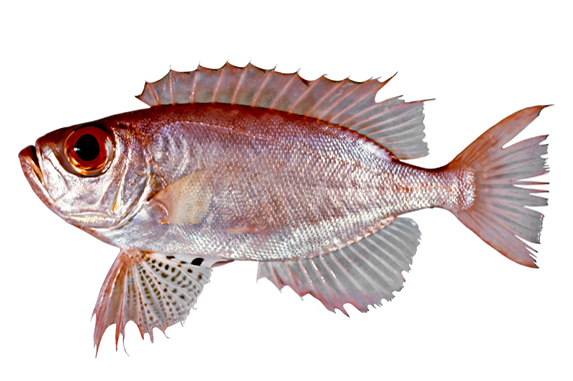Purplespotted Bigeye, Priacanthus tayenus Richardson 1846
Other Names: Purplespot Bigeye, Spotted-finned Bullseye, Threadfin Bigeye, Threadfin Big-eye

Purplespotted Bigeye, Priacanthus tayenus. Source: Australian National Fish Collection, CSIRO. License: CC BY Attribution-Noncommercial
Summary:
A reddish or silvery white bigeye with pink tinges, pinkish fins and distinctive deep purple to ink-black spots on the pelvic-fin membranes, including large spots on the membrane joining the abdomen. The species has relatively tall soft dorsal and anal fins, and filamentous tips on the tail.
Video of presettlement behaviour of larval Purplespotted Bigeyes filmed using pelagic BRUVs (Baited Remote Underwater stereo-Video systems) off Coral Bay, Western Australia, depth 35 m.
Video of presettlement behaviour of larval Purplespotted Bigeyes filmed using pelagic BRUVs (Baited Remote Underwater stereo-Video systems) off Coral Bay, Western Australia, depth 35 m.
Cite this page as:
Bray, D.J. 2022, Priacanthus tayenus in Fishes of Australia, accessed 20 Apr 2024, https://fishesofaustralia.net.au/Home/species/1832
Purplespotted Bigeye, Priacanthus tayenus Richardson 1846
More Info
|
Distribution |
Shark Bay, Western Australia, to south of Cartier Island, Timor Sea, Western Australia, and off Innisfail to off Gladstone, Queensland. Elsewhere the species is widespread in the tropical Indo-west Pacific: Socotra, the Arabian/Persian Gulf and Gulf of Oman to India, east to the Indo-Malayan region, north to Taiwan and south to the Solomon Islands. Adults are benthopelagic, inhabiting inshore and offshore rocky reefs and sometimes open bottom areas where they may form large schools at depths of 20-200 m. Larvae and early juvenile stages are pelagic, and presettlement stage individuals may form schools (Santana-Garcon et al. 2014). |
|
Features |
Dorsal fin X,11-13; Anal fin III,12-14; Lateral line, pored scales 51-67; Vertical scale rows (dorsal origin diagonally to anus) 40-50. Body moderately deep and elongate, laterally compressed anterior profile slightly asymetrical, extremity of protruding lower jaw usually slightly above level of midline of body; preopercular spine well developed at all sizes; dentary, vomer, palatines, and premaxillaries with small teeth. Caudal fin more or less truncate in smaller specimens, becoming very lunate in some (possibly males) but not all larger specimens. |
|
Colour |
Pink to reddish, or silvery white with pink tinges, fins pinkish; pelvic fins with small dark purple to blackish spots on the fin membranes, including one or two larger spots on the membrane connecting the fin to the abdomen. |
|
Feeding |
Feeds on a other fishes and a range of benthic invertebrates, including crustaceans and molluscs. |
|
Fisheries |
A component of mixed-species fisheries in parts of its range. |
|
Etymology |
The specific name tayenus is presumably a latinization of Ta yan from Ta yen lap (=Large-eyed lap), the Chinese name for this fish as reported John Reeves, who painted the species while working as a tea inspector in China (Scharpf & Lazara 2020) |
|
Species Citation |
Priacanthus tayenus Richardson 1846, Rept 15th mtg Brit. Assoc. Adv. Sci. 1845: 237. Type locality: Canton, China. |
|
Author |
Bray, D.J. 2022 |
|
Resources |
Purplespotted Bigeye, Priacanthus tayenus Richardson 1846
References
Allen, G.R. 1997. Marine Fishes of Tropical Australia and South-east Asia. Perth : Western Australian Museum 292 pp. 106 pls.
Allen, G.R. & Swainston, R. 1988. The Marine Fishes of North-Western Australia. A field guide for anglers and divers. Perth, WA : Western Australian Museum vi 201 pp., 70 pls.
Awong, H., Ibrahim, S., Somo, K. and Ambak, M.A. 2011. Observation on weight-length relationship of Priacanthus tayenus. World Journal of Fish and Marine Sciences 3(3): 239-242.
Blaber, S.J.M., Brewer, D.T. & Harris, A.N. 1994. Distribution, biomass and community structure of demersal fishes of the Gulf of Carpentaria, Australia. Australian Journal of Marine and Freshwater Research 45(3): 375-396.
Carpenter, K.E., Lawrence, A. & Myers, R. 2016. Priacanthus tayenus. The IUCN Red List of Threatened Species 2016: e.T46087917A46664869. https://dx.doi.org/10.2305/IUCN.UK.2016-3.RLTS.T46087917A46664869.en. Accessed on 01 March 2022.
Gloerfelt-Tarp, T. & Kailola, P.J. 1984. Trawled Fishes of Southern Indonesia and Northwest Australia. Jakarta : Dir. Gen. Fish. (Indonesia), German Tech. Coop., Aust. Dev. Ass. Bur. 406 pp.
Grant, E.M. 1975. Guide to Fishes. Brisbane : Queensland Government, Co-ordinator General’s Department 640 pp.
Larson, H.K., Williams, R.S. & Hammer, M.P. 2013. An annotated checklist of the fishes of the Northern Territory, Australia. Zootaxa 3696(1): 1-293
Leis, J.M., Carson-Ewart, B.M. & Webley, J. 2002. Settlement behaviour of coral-reef fish larvae at subsurface artificial-reef moorings. Marine and Freshwater Research 53: 319-327.
Lester, R.J.G, 1968. Feeding of Priacanthus tayenus and P. macracanthus near Hong Kong. Publications of the Seto Marine Biological Laboratory 16(1): 1-6.
Lester, R.J.G. & Watson, R.A. 1985. Growth, mortality, parasitism, and potential yields of two Priacanthus species in the South China Sea. Journal of Fish Biology 27(1985): 307-318.
Richardson, J. 1846. Report on the ichthyology of the seas of China and Japan. Report of the 15th meeting of the British Association for the Advancement of Science 1845: 187-320 See ref at BHL
Russell, B.C. & Houston, W. 1989. Offshore fishes of the Arafura Sea. The Beagle 6(1): 69-84.
Sainsbury, K.J., Kailola, P.J. & Leyland, G.G. 1985. Continental Shelf Fishes of Northern and North-Western Australia. Canberra : Fisheries Information Service 375 pp. figs & pls.
Salini, J.P., Blaber, S.J.M. & Brewer, D.T. 1994. Diets of trawled predatory fish of the Gulf of Carpentaria, Australia, with particular reference to predation on prawns. Australian Journal of Marine and Freshwater Research 45(3): 397-411.
Santana-Garcon, J., Leis, J.M., Newman, S.J. & Harvey, E.S. 2014. Presettlement schooling behaviour of a priacanthid, the Purplespotted Bigeye Priacanthus tayenus (Priacanthidae: Teleostei). Environmental Biology of Fishes 97. https://doi.org/10.1007/s10641-013-0150-6.
Scharpf, C. & Lazara, K.J. 2020. The ETYFish Project. Fish Name Etymology Database, accessed 02 Mar 2022, https://etyfish.org/priacanthiformes/
Starnes, W.C. 1988. Revision, phylogeny and biogeographic comments on the circumtropical marine percoid fish family Priacanthidae. Bulletin of Marine Science 43(2): 117-203 See ref online
Starnes, W.C. 1999. Family Priacanthidae. pp. 2590-2601 in Carpenter, K.E. & Niem, T.H. (eds). The Living Marine Resources of the Western Central Pacific. FAO Species Identification Guide for Fisheries Purposes. Rome : FAO Vol. 4 pp. 2069-2790.




